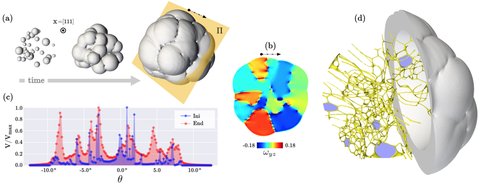Apr 11, 2019
Crystallography: TUD mathematicians close the gap between atomic-scale lattice deformations and continuum elasticity

Dislocation network in polycrystalline material
Dr. Marco Salvalaglio and Prof. Axel Voigt from the Institute of Scientific Computing at TU Dresden, in cooperation with the physicist Prof. Ken R. Elder from Oakland University, USA, have succeeded for the first time in combining the microscopic and macroscopic description of crystal lattice deformations. The study enables the detailed analysis of elasticity effects for macro- and mesoscale systems taking microscopic details into account. Today their results are published in the online journal npi Computational Materials, a Nature Partner Journal.
In crystallography, there are two conventional ways to describe crystal lattice deformations: on the microscopic level by explicitly considering the position of atoms, and on the macroscopic level by continuum elasticity. The interdisciplinary research team around Prof. Axel Voigt are now the first to publish the description of continuous elastic fields derived from an atomistic representation of crystalline structures with microscale features.
Analytical expressions for strain components are obtained from the complex amplitudes of the Fourier modes representing periodic lattice positions, which can be generally provided by atomistic modeling or experiments. The magnitude and phase of these amplitudes, together with the continuous description of strains, are able to characterize crystal rotations, lattice deformations and dislocations. Furthermore, in combination with the so-called amplitude expansion of the phase-field crystal model, they represent a suitable tool for the combination of microscopic and macroscopic scales.
The scientists show that the elastic ield in presence of defects as computed from the complex amplitudes coincide with the results of continuum elasticity, taking into account the contribution of dislocations. The rotation field in tilted crystals and polycrystalline systems is also addressed and provides ready-to-use orientational order parameters. This study enables the in-depth analysis of elasticity effects for macro- and mesoscale systems under consideration of microscopic details.
"Together with improvements in numerics and the use of high-performance computers, this opens up a novel, detailed description of materials," says Prof. Voigt about the significance of current research results for materials science.
Original publication:
Marco Salvalaglio, Axel Voigt, Ken R. Elder, Closing the gap between atomic-scale lattice deformations and continuum elasticity. npj Computational Materials 11.04.2019. https://doi.org/10.1038/s41524-019-0185-0
Contact:
Prof. Dr. Axel Voigt
Institute of Scientific Computing
Tel. +49 351 463-34187
Email:
